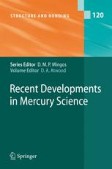Search
Search Results
-
n-Body Decomposition Approach to the Calculation of Interaction Energies of Water Clusters
A new methodology is proposed in which large basis set MP2-level calculations can be extended to water clusters with as many as 50 monomers. The...
-
Multiporphyrin ArraysAssembled Through Hydrogen Bonding
Although relatively weak in isolation, composite H-bonds can be used as an advantage for the assembly of relatively robust and well-defined arrays...
-
Axial Coordination to Metalloporphyrins Leading to Multinuclear Assemblies
The use of axial coordination to metalloporphyrins is discussed on the basis of constructing multinuclear complexes. Starting with single...
-
Mercury Removal from Water
Mercury pollution in water is a serious threat to natural ecosystems. Various methods and technologies are in use to remove mercury from the...
-
Phase behavior of phytanyl-chained akylglycoside/water systems
The aqueous phase behavior of novel alkylglycosides, AGs, that have a 3,7,11,15-tetramethylhexadecyl (phytanyl) group as their hydrophobic part was...
-
About energy and electron transfer processes in C60 /phthalocyanine films
In the present work absorption, photoluminescence excitation and emission spectra of fullerene C60, and a zinc derivative of phthalocyanine (ZnPc) in...
-
Determining antioxidant distributions in model food emulsions: development of a new kinetic method based on the pseudophase model in micelles and opaque emulsions
The mechanisms of lipid peroxidation and the distributions of antioxidants in emulsions are not fully understood, in a large part because...
-
Methods and Instrumentation
On the basis of the given brilliances of present-day synchrotron radiation sources one easily estimates that they should be ideally suited for...
-
Coherent Elastic Nuclear Resonant Scattering
In the field of x-ray diffraction, the intensity and the direction of scattered waves are determined by the properties of the individual scatterers...
-
5. Simulation of Active and Nonlinear Photonic Nano-Materials in the Finite-Difference Time-Domain (FDTD) Framework
A numerical method is presented that unites three-dimensional finite-differnce time-domain (FDTD) computer simulations of active, nonlinear photonic...
-
13. Parallel Implementation Strategiesfor Algorithms from Scientific Computing
Many applications from scientific computing are computationally intensive and can therefore benefit from a realization on a parallel or a distributed...
-
Introduction
The scattering of x-rays is a very powerful tool to investigate the structure and dynamics of condensed matter. The research in this field can be...
-
Outlook and Perspectives
Nuclear resonant scattering has significantly benefitted from the development of third-generation synchrotron radiation sources. This trend will...
-
General Aspects of Nuclear Resonant Scattering
Nuclear resonant scattering (NRS) unites a number of different scattering processes that can be used to investigate properties of condensed matter....
-
Adsolubilization by mixtures of ionic and non-ionic surfactants
The adsolubilization of 2-naphthol by surfactant mixtures of ionic and non-ionic surfactants has been investigated for three systems; sodium dodecyl...
-
Salt-induced aggregation in cationic liposome suspensions
The simple salt-induced aggregation of small unilamellar dioleoyltrimethylammoniumpropane [DOTAP] vesicles is investigated by measuring the change in...
-
Specific ion effects: why colloid science has failed to contribute to biology
Surface tension of salt solutions and double layer forces between charged interfaces show marked specific ion effects not accommodated by the...
-
Enzymatic activity of lipase entrapped in CTAB/water/pentanol/hexane reverse micelles: a functional and microstructural investigation
The lipase VII (from Candida rugosa) activity was studied as a function of the content of pentanol and water in cethyltrimethylammonium bromide...
-
Rates of incorporation of small molecules into pluronic micelles
The kinetics of incorporation of the hydrophobic dye 1,6 diphenyl-1,3,5-hexatriene (DPH) into block copolymer micelles (F127) have been studied using...
-

